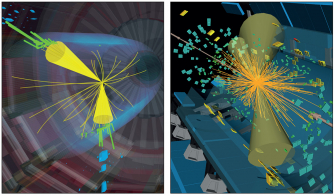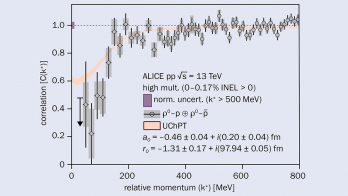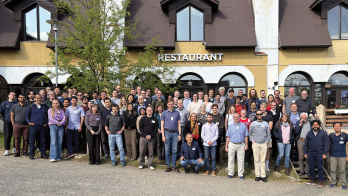
The 19th international conference on strangeness in quark matter (SQM) was hosted virtually by Brookhaven National Laboratory from 17 to 22 May, attracting more than 300 participants. The series deals with the role of strange and heavy-flavour quarks in high-energy heavy-ion collisions and astrophysical phenomena.

New results on the production of strangeness in heavy-ion collisions were presented for a variety of collision energies and systems. In an experimental highlight, the ALICE collaboration reported that the number of strange baryons depends more on the final-state multiplicity than the initial-state energy. On the theory side, it was shown that several models can explain the suppression of strange particles at low multiplicities. ALICE also presented new measurements of the charm cross section and fragmentation functions in proton–proton (pp) collisions. When compared to e+e– collisions, these results suggest that the universality of parton-to-hadron fragmentation may be broken.
Moving on to heavy flavours, the ATLAS collaboration presented results for the suppression of heavy-flavour production compared to pp collisions and the angular anisotropy of heavy mesons in heavy-ion collisions. These measurements are crucial for constraining models of in-medium energy loss. Interestingly, while charm seems to follow the flow of the quark–gluon plasma, beauty does not seem to flow. Better statistics are needed to constrain theoretical models. On the theory side, extremely interesting new calculations using open quantum systems coupled with potential non-relativistic QCD calculations were used to compute both the suppression and anisotropic flow of bottomonium states.
Hints of extrema
Another important goal of the field is to determine experimentally whether a critical point exists in the phase diagram of strongly interacting matter, and, if so, where it is located. The STAR experiment at the Relativistic Heavy Ion Collider (RHIC) presented results on higher order cumulants of net-proton fluctuations over a range of collision energies. Extrema as a function of beam energy are expected to indicate critical behaviour. New data from the Beam Energy Scan II programme at RHIC is expected to provide much-needed statistics to confirm hints of extrema in the data. On the theory side, new lattice QCD calculations of second-order net-baryon cumulants were presented, as well as new expansion schemes to extend the lattice-QCD equation of state to larger net baryon chemical potentials that are not computable directly, because of the fermion-sign problem. Another study included the lattice-QCD equation of state and susceptibilities in a hydrodynamic calculation to allow for a more direct comparison to experimental measurements of net-proton fluctuations. Significant differences between net-proton and net-baryon fluctuations were quantified.
The study of the quark–gluon plasma’s vorticity via the measurement of the polarisation of hyperons was also a major topic. Theoretical calculations obtain the opposite sign to the data for the angular differential measurement. Attempts to solve this discrepancy presented at SQM 2021 featured shear-dependent terms and a stronger “memory” of the strange-quark spin.
Various new applications of machine learning and artificial intelligence were also discussed, for example, for determining the order of the phase transition and constraining the neutron-star equation of state.
Overall, there were 41 plenary and 96 parallel talks at SQM 2021, poignantly including presentations in memory of Jean Cleymans, Jean Letessier, Dick Majka and Jack Sandweiss, who all made exceptional impacts on the field.
The next SQM conference will be held from 13 to 18 June 2022 in Busan, South Korea.








